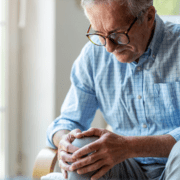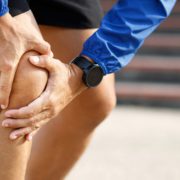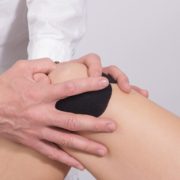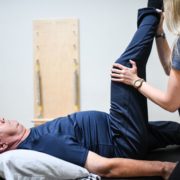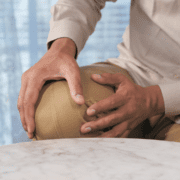Knee Pain? Top 3 Causes and What You Can Do.
Knee pain impacts one-third of all Americans, and annoyingly interferes with activities of daily life. Such activities could be as simple as walking, squatting, going up and down stairs, and getting in and out of the car. This is in addition to the multitude of recreational activities knee pain can impact.
It’s the second most common complaint behind back pain when it comes to musculoskeletal problems. It’s one of the most common complaints I still hear about that started or worsened during the pandemic.
But what if there was a way to address some of the most common causes of knee pain on your own – without procedures or surgery?
Here are three of the most common causes of knee pain I see and what you can do to resolve it – naturally:
1. Patellofemoral Knee syndrome
Also known as “runner’s knee”, patellofemoral knee syndrome (PFS) is characterized by pain in the front of your knee. Usually this is just below or behind your knee cap. With PFS, the source of the pain typically comes from unwanted pressure around your knee cap. This will eventually results in inflammation and pain.
It’s very tempting to just get a cortisone shot or take pain pills to quickly reduce the inflammation and relieve your pain. But the problem with this approach is that you’re only putting a bandaid on symptoms. Inflammation is the result of an angry kneecap – not the cause. What you need to figure out is what is causing your knee cap to get angry in the first place.
Typically, PFS is the result of an imbalance somewhere in your body, typically from poor form and movement habits. Over time, this ultimately causes more pressure at your knee cap. If your hips, quads (front of the thigh), and hamstrings (back of the thigh) aren’t balanced and working together, for example, you could end up with problems with the way your knee cap tracks and functions. This will make your knee cap angry and inflamed over time.
When you figure out the true culprit behind the pressure and inflammation at your knee cap, you’ll not only be able to resolve and manage PFS naturally and for the long-term, but you can avoid temporary band-aid treatments.
2. Iliotibial band syndrome
The causes of iliotibial band syndrome are very similar to that of PFS. Except that your pain and symptoms will be experienced on the side of your knee instead of the front. Your iliotibial band (ITB) is a large band of tissue that runs along the side of your thigh to the bottom of your knee. Your ITB is formed from a muscle in your hip called the tensor fascia latae (TFL). When your TFL gets overworked, your ITB suffers. It will result in what often feels like stabbing pain at the side of your knee.
The most common treatment I see for this is foam rolling and massage. While these are great modalities to relieve your symptoms, they don’t address the root problem. You must figure out why your TFL is being stressed and overworked if you really want to get rid of your pain. Typically, it’s due to weak glute muscles, the deep ones designed to stabilize your pelvis. Your TFL is neighbor to your glutes. So when they decide to be lazy, your TFL loves to help out, and eventually overdoes it. When you can get these two groups of muscles working properly together, you’ll put an end to ITB syndrome.
3. Osteoarthritis
This is a very hot topic and everyone wants to know if they have it. (Spoiler alert – if you’re over the age of 50 – you already do.) Osteoarthritis happens naturally over time and is a normal part of aging. The problem with arthritis is that it only gets paid attention to when you’ve got pain. Then it gets blamed for all your problems. Arthritis certainly plays a role in your mobility and quality of movement. But it’s not the “death sentence” that many make it out to be. Many people find out they have osteoarthritis in their knees and think they have to just “live with it” or get a total knee replacement.
Remember, arthritis is normal and it happens to everyone as they age. What is not normal is for you to think you’re helpless or have to avoid your favorite activities because of it.
Arthritis occurs when the protective cartilage that cushions the ends of your bones wears down over time. There isn’t anything you can do to reverse this process. But, there is plenty you can do to minimize the symptoms you get because of this condition. It all comes down to balanced joints and movement. The more mobility you have, and the more stability you have around your knees, the less symptomatic your arthritis will be.
Some key areas to focus on when you’ve got arthritis in your knees is good core and hip strength. As well as good flexibility in your hips and ankles. If anything is off in these areas, your knees will want to compensate. This could result in compression at your knee joint and aggravation of your arthritic symptoms.
There is no need to rely on pain pills, or believe that procedures and surgery are your only options when it comes to knee pain.
As you can see, three of the most common causes of knee pain are due to – or influenced – by movement problems. Therefore, movement should be your go-to solution – not something you avoid.
If you’re having difficulty using movement as your solution and you want to contact a movement expert who understands mechanical knee pain and can diagnose the root cause of your knee problem – consider speaking to one of my specialists!
In your free Discovery Session we will ask you all about what’s been going on & see if we would be a good fit to help you. Book your free discovery session HERE.

